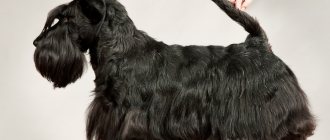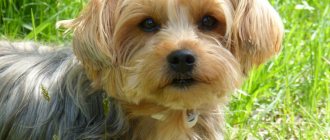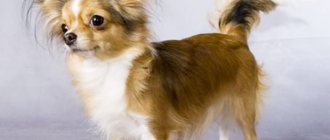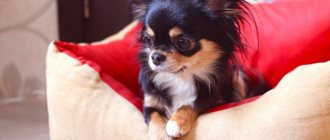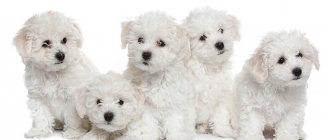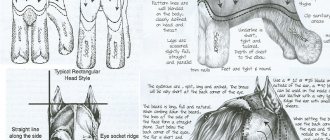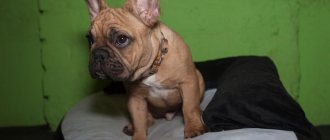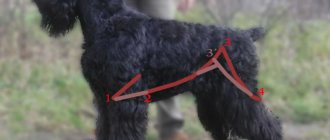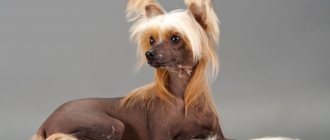The first representatives of the breed appeared in England in the Middle Ages, and it was here that a group of hunting dogs called terriers was formed.
Such dogs were used to hunt foxes, badgers and rats.
The small Manchester terrier was considered the best rodent hunter.
But only in the 17th century this breed was identified as a separate category, and later received the name toy terrier, translated from English as toy.
Are there any indications?
Docking is done to avoid the creases that often accompany this breed. A long tail is also allowed by the exterior, but it must be curled into a sickle. If the species is different, the dog is no longer considered purebred. She is prohibited from participating in exhibitions and breeding.
Medical indications for tail docking in toys are rare. Surgery is only performed if the dog has had a serious injury, such as a fracture, and the animal cannot recover.
A long tail hides exterior flaws in the rear of the body, while a short tail exposes them. If your pet has imperfections that can be covered with a tail, it is better to leave it so as not to displease the judges at shows.
Diseases
Long-haired toy terriers (mini and standard) are distinguished by fairly good health. But, like any other living beings, they sometimes get sick. Due to their miniature size, they are easily injured. Therefore, you should not allow them to jump from heights. Otherwise, the animal’s thin, fragile bones may not be able to withstand such a load. For the same reasons, they should not be left alone with small children, who could accidentally harm the tiny dog.
Many representatives of this breed are susceptible to allergies to household chemicals and food. The disease can manifest itself in the form of swelling and wet eczema on the skin. They also have an excellent appetite, which means they are prone to obesity. Therefore, owners must carefully monitor the diet of their little charges and not overfeed them.
Longhaired Toy Terrier puppies often have problems with changing teeth. It happens that the milk line does not fall out on its own and has to be removed by a veterinarian. If this is not done, the dog’s bite will deteriorate and digestive problems will arise.
How to choose the right time
If the puppy has congenital abnormalities in growth or development, the procedure is not performed. It is prohibited to dock the tail if the dog has become infected with an infectious, viral or fungal disease. A weakened immune system cannot cope with the consequences of surgery. It is advisable to postpone the procedure for a while if the pet is not eating well, shows apathy or aggression.
Toy terriers have their tails docked at the age of 3 to 7 days, when the structure of the spine is more like cartilage. The operation will not cause psychological or physical trauma to the puppy, although it will still hurt. The procedure is performed without anesthesia and no stitches are required, which reduces the risk of complications.
Adult dogs' tails are cut only for medical reasons. If you didn't do this while the puppy was small, then time was lost.
The operation will be serious, since adult dogs require anesthesia, and after it there is a high risk of complications. Not every veterinarian will agree to harm an animal at the whim of the owner, although theoretically such a procedure is possible.
Preparation and stages of the procedure
If anesthesia is expected, it is necessary to undergo tests in advance - it can harm some dogs. 12 hours before surgery you cannot feed the toy, you can only give him water. It is better to isolate the mother so that she does not try to give the puppy her milk. On the day of the procedure, it is necessary to examine the pet’s fur and skin. There should be no rashes, bald spots or other signs of illness. There should be no discharge from the ears and eyes.
Many veterinarians ask owners to be present during surgery to hold the pet unless general anesthesia is used. You need to grab the toy terrier with your hands on both sides and hold it with its muzzle down.
The veterinarian will do the following:
- Wrap the tail with a sterile bandage above the circumcision site to reduce the risk of bleeding.
- He will feel the tail to outline the docking line - it should pass between two adjacent vertebrae.
- Apply antiseptic.
- Using a scalpel or strong scissors, cut off the tail along the intended line.
- Treat the wound with an antiseptic.
- If necessary, he will apply stitches.
- Unties or cuts the bandage.
The process takes about 5 minutes. All this time, the puppy will struggle and squeak, so be prepared to behave calmly so as not to provoke a veterinarian error. If the dog is an adult, then the presence of the owner is not necessary - it will simply be anesthetized by injection or inhalation. Usually, at the same time as tail docking, the fifth toes on the front paws are removed, so as not to further injure the puppy later.
Education and training
Some owners mistakenly believe that small dogs do not need training. As a result, they grow up with ill-mannered animals that climb on sofas, growl at random passers-by, jump on strangers and bark continuously over trifles. To prevent this from happening to your dog, you need to deal with it from the first days of its appearance in the house.
Of course, the long-haired toy terrier, a photo of which can be seen in today’s publication, does not have to undergo a full training course. For comfortable living together, it is enough for him to unquestioningly carry out several basic commands, including “Come to me”, “Place”, “Ugh”, Sit” and “Lie down”. If desired, the tiny dog can be taught several circus tricks. For the training process to be enjoyable for both you and the dog, it must be done in a playful way.
Breed standard
The specific length of the tail is not specified in the breed's conformation. Usually only 2-3 vertebrae are left from the appendage. A toy terrier with a tail falls under other requirements. The appendage should be positioned in the shape of a sickle, but not cross the line of the back. If the dog participates in shows, it will be difficult for him to keep his tail in this position during a staged trot, which is why some owners decide to trim it.
Source of the article: https://bobik.online/uhod/kak-kupiryut/hvost-toj-tereru.html
Do I need to cut my Toy Terrier's hair?
There are three varieties of Toy Terriers :
In turn, dogs of the Russian Toy Terrier breed are usually divided into two types:
This division is characteristic only of the Russian Toy - dogs of the English and American varieties are exclusively short-haired.
Smooth-haired Toys do not require a haircut, as their coat looks great without it.
Here only standard care :
Long-haired dogs, among other things, also require a haircut in order for the pet to look more neat. These dogs should have the hair on their paws and lower belly trimmed from time to time. But sometimes owners prefer to trim the Russian Longhaired Toy completely.
English and Russian Toy Terrier: differences
First of all, it should be said that there are two varieties of the breed: Russian and English Toy Terrier, and one is not like the other. The English Toy Terrier appeared in the 19th century, and the Russian was bred by Moscow dog handlers in the mid-20th century, and is smaller in size than the English one. In addition, the Toy Terrier from England is only short-haired, while the Russian is both short-haired and long-haired. It is precisely for the long-haired variety that such a service as grooming a toy terrier is most relevant.
Should you cut your hair yourself or leave it to a professional?
If you decide to trim your pet, it is better to use the services of a professional specialist. This will give you a guarantee that the procedure will be performed efficiently and the animal will not be harmed.
In addition, after visiting a professional grooming salon, your pet will definitely look not only well-groomed, but also stylish.
There is a second option - you can cut your pet’s hair yourself, but only practice will show what will come of it.
Summarizing
The Longhaired Toy Terrier is a charming little dog with a doll-like appearance, but a big and brave heart. Such a pet should be owned by a sensitive and gentle person who understands how important walks, training and a caring attitude are for a dog.
If the owner can properly socialize the toy terrier, give him enough opportunities to show his high intelligence, and devote a lot of time and effort to him, then he will receive a faithful friend and companion for any activity, be it a long journey, an interesting walk, or just watching TV on sofa
Active walks mean a healthy dog!
Basic types of haircuts
As for toy terriers, there are three main types of haircuts:
- hygienic , when only the hair that is in the way is trimmed. The purpose of the procedure is to create more comfortable conditions for the animal and make it easier to care for;
- classical _ The idea is to leave the coat as long as possible. In this form, the dog looks as natural as possible, but at the same time it has a well-groomed appearance. In this case, special attention is paid to the scruff, ears, paws and tail;
- model _ There are a lot of different options here, from thinning the tips on the ears to cutting out various patterns on the animal’s fur. This also includes various decorations (rhinestones, hairpins, etc.).
Vaccination
As a rule, professional breeders sell fully vaccinated puppies. But sometimes it happens that new owners have to do this. A long-haired toy terrier should be vaccinated only after he is six to eight weeks old. This is done with complex vaccines that provide reliable protection against viral hepatitis, plague, leptospirosis, enteritis, parainfluenza and rabies.
Two weeks before the proposed vaccination, the puppy must be treated for helminths. For several days after vaccination, it is necessary to closely monitor the general condition of the puppy. It is extremely important to observe post-vaccination quarantine. To do this, the dog should not be allowed to come into contact with other animals for two weeks after the injection.
What standards are there?
According to international breed standards , the Toy Terrier should look like this:
- the dog's body should be covered with hair 3 to 5 cm long;
- The coat on the body can be straight or slightly wavy, lying close to the body, but not hiding its natural contours. The curves of the body should be clearly visible;
- if the hair on the dog’s body is too disheveled, this is considered a fault and may lead to a decrease in points at the show;
- on the front legs of long-haired toy terriers the hair should be short, and on the hind legs it should be slightly longer;
- The ears deserve special attention. They should be densely covered with hair that falls in the form of a fringe. If the animal is older than three years, the hair should completely cover both the outer edges of the ear and the tips.
Behavioral features
Representatives of this breed are unusually active and energetic. In character they are somewhat reminiscent of Jack Russell Terriers. Long-haired Toys are very impulsive and temperamental. They have a loud, ringing voice and use it for any reason. It is almost impossible to wean them from constant barking. These playful and affectionate animals are very loyal to their owners and get along well with other pets. At the same time, tiny dogs have a flexible psyche. They are very impressionable, fearful and prone to stress. We must not forget that obsessive attention from a person can provoke nerve problems in a dog.
Despite the fact that the Russian Longhaired Toy Terrier is friendly towards other pets, he will not refuse to chase someone else’s cat or birds around the yard. Moreover, he does it so recklessly that he does not hear the owner’s commands. He remains playful throughout his life and even in old age will happily run after a ball. Its tiny size does not prevent it from being suspicious of strangers and challenging larger dogs. Therefore, owners of cocky representatives of this breed need to be very careful while walking.
Photos of haircuts for boys
Owners of toy terrier boys in most cases prefer simple haircut options. A classic and hygienic haircut is the main trend. Here it all comes down to trimming split ends, removing tangles (if any) and giving your pets a neat appearance.
In the summer, some owners prefer to cut their toy terriers “puppy style.” The point of this hairstyle is to remove as much hair as possible, after which the dog looks very young and resembles a puppy.
Feeding recommendations
These small, unpretentious dogs can eat both industrial and natural food. If you decide to give your pet the so-called “drying”, then it is advisable to opt for high-quality products from trusted manufacturers. In many large cities, like Moscow, a long-haired toy terrier can easily find good food that does not contain corn, wheat, dyes or preservatives.
If you are a supporter of natural nutrition, then try to remember that the basis of a dog’s diet is meat (beef, chicken, turkey or lamb). Also, the toya menu must be supplemented with buckwheat, rice, eggs, cottage cheese, kefir, offal, vegetables and low-fat sea fish. The diet of a miniature dog should absolutely not contain sweets, chocolate, smoked meats and pickles. You cannot treat animals with baked goods, river fish, tubular bones, legumes, spicy and fried foods.
Photos of haircuts for girls
The owners of girls choose both classic haircuts and model hairstyles. Here, special attention is paid to the furry ears. The wool on them is carefully trimmed and then milled with scissors to create a neat fringe. They do the same with the ponytail. At the same time, they try to cut the fur on the paws as short as possible. In this form, the toy terrier girl looks elegant and stylish.
Often in hairstyles for girls, rhinestones or miniature pendants are used to decorate the ears.
Some go even further and cut patterns on the backs of their pets or dye the fur on the ears and tail. Moreover, the color scheme can be very different, from bright red to green.
Varieties and standards of long-haired terriers
The modern classic long-haired Toychik is a miniature dog with a square format and an elegant small head. The average height at the withers is about twenty-five centimeters; toy terriers weigh about three kilograms.
Features characteristic of the appearance of the Russian Toy are a cute and sharp muzzle, dark large bulging eyes, long thin legs with woolen fringes, large erect ears framed with wool. The purebred longhaired Toy has an elegant, refined bone structure.
Elegant Russian Toy
Despite the fact that the breed is called a long-haired toy terrier, within it there is a division into dogs with smoother, shorter hair, and into “long-haired” ones. At the same time, there are no other external differences or nuances in the psyche and behavior of the types of Moscow terriers. At the same time, smoother-haired dogs often give birth to long-haired puppies, but the opposite does not happen.
Sometimes you can hear such a characteristic of a toy terrier as “dwarf”. In fact, we are not talking about a separate type of very small representatives of the breed, but simply about extremely miniature dogs. In fact, dwarfism is a disadvantage and even a disease - such toy terriers not only pass the lower limit of height and weight, but also have an open fontanel on the head, extremely fragile bones, problems with metabolism and vision.
The Longhaired Toy Terrier should be miniature, but not dwarf.
A standard healthy toy terrier should meet the following characteristics:
- Square body, with a deep oval chest, light springy ribs.
- A rounded loin, through which the strong back meets the sloping croup.
- A long graceful but muscular neck, the bend of which is well defined.
- Almost absent withers - the neck smoothly flows into a harmonious, small head.
- Convex forehead, the transition from the skull to the muzzle is clearly expressed. The cheeks are weakly filled, the eye sockets are not convex, the nose is small and dark (black or close to it).
- Bite – “scissors”, teeth are even, white, vertically located.
- Thin triangular ears, set high on the head, standing on elastic cartilage.
- Smooth, well-developed muscular limbs, vertical wrists and pasterns. Short, undeveloped shoulder blades, wide, well-developed hips, poorly defined joints. The dog's paws are tightly packed, the fingers are bent, and have an oval shape. Claws - the shade of the nose or the main tone of the coat.
- A sickle-shaped tail lying along the line of the spine, which according to the standard should be docked at the second or third vertebra.
- Acceptable colors include: red, black, brown, blue and combinations.
On the left is a smooth-haired toy, on the right is a long-haired one.
Table. Advantages and disadvantages of the breed
| pros | Minuses |
| Well suited for keeping in a small apartment | Able to manipulate the owner and other family members |
| Doesn't require long walks | Susceptible to injury (particularly sprains and fractures from falls or jumps) |
| Get by on small amounts of food | May be cowardly or hysterical |
| Easy to care for | Gets very cold in cold weather, needs to be dressed |
| Has an affectionate, loyal and peaceful nature | He is whimsical in terms of feeding, suffers from allergies |
| Good with children | Has a tendency to a number of diseases |
| Quickly finds a common language with other pets | Does not tolerate loneliness and separation from owner well |
Required Items
If you decide to trim your pet yourself, you will need:
- sharp hairdressing scissors;
- thick single-row metal comb;
- slicker;
- brushes and combs for routine care.
But that is not all. The place where the pet is cut is of great importance. After all, during the processing process he should feel comfortable, convenient and safe.
The best option is a standard height table or bar counter. The place for the procedure should be well lit and covered with a cloth or a special rug so that the dog’s legs do not move apart and he feels calm.
Rules for caring for a long-haired toy terrier
Even such a miniature and decorative pet as a long-haired toy is still a dog and requires proper care, attention and education. It is impossible for a dog to grow on its own, so the owner must devote time not only to feeding and hygiene procedures, but also to training the baby.
You can start training your toy terrier as early as three months.
Upbringing
The first thing the owner of a toy terrier should know is that this little dog, no less than other, larger representatives of the canine world, needs education and a firm hand. No, this is not at all about hitting the toy - it’s absolutely not worth doing this. But when you get a puppy, you need to learn a few important rules from the first day:
- Explain to the dog what is allowed and what is not allowed - this applies to a place to sleep, eat, and play. The dog should sleep in a designated place, a warm and cozy bed should be equipped in the room where family members most often gather, but not on the aisle, not near the radiator or next to the window - the baby should be protected from drafts and overheating.
- The dog should have its own bowl for food and a second bowl for water. You should not allow your pet to beg at the table or take food to a secluded corner.
The dog should have two bowls
- The puppy needs to buy several toys that he will scratch his teeth on and with which he can have fun while no one is home.
- Teaching your dog to relieve himself in a diaper or in a litter box will help the baby not have to wait until he goes out for a walk if the owner is late at work.
- The dog must be accustomed to walking on a leash, and also respond to the command “Come to me” and its own name. First of all, this is necessary for the safety of the animal itself. There is no need to assume that a small dog is not dangerous to others, and therefore can walk on its own - a pet running without a leash can be hit by a car, bitten by a larger dog, or even taken by a passerby who thinks that the baby has no owner.
Let's learn the command "Come to me!"
Health
The owner of a toy terrier, especially a female dog, must understand that he bears great responsibility for a fragile creature. Why do we especially emphasize the importance of care for owners of female dogs? This is due to a common misconception - a dog must give birth at least once “for health.” This is fundamentally wrong, and for a miniature breed it can be fatal. Both pregnancy and childbirth are a lot of stress for a dog, and for a small toy terrier it is also a serious burden. There is no need to breed a dog just like that, without special knowledge and skills - due to its tiny size, the dog can die in childbirth.
Another health feature of long-haired Russian Toys is their tendency to alopecia or partial baldness. Most often, dogs lose their hair around the age of three; this is due to an unbalanced diet, poor care or heredity. To prevent your pet from losing its luxurious fur, it is necessary to undergo a veterinary examination at least once a year, since it is easier to prevent a disease than to treat it.
An annual visit to the veterinary clinic is beneficial for both the dog and the owner - for peace of mind
The last thing that can be said about maintaining the health of the Russian Toy is the importance of preventing injuries. A small dog can jump from furniture and break a leg, crawl under a sofa or closet, and die when it gets stuck. The dog may be accidentally stepped on, pinned by a door, or something heavy may be dropped on it. Therefore, it is not recommended to bring Toy Terriers into a family with small children who do not understand such responsibility. And the rest of the household must be extremely careful so as not to harm the baby.
Yes, a small dog is not a toy; it can cause a lot of trouble and take away a person’s time for affection, care and care. However, with the latter things are not so difficult.
Caring for a Toy Terrier's coat is not that difficult.
Treatments
Despite the fact that even the name of the breed contains the word “long-haired,” the Moscow Toy Terrier does not require special care. The dog needs to be brushed a couple of times a week, using a brush or a long-toothed comb, and the baby can be bathed when dirty or once every three to four months. To wash your dog, you need to use a special zoo shampoo with a gentle composition and a pH level suitable for the dog’s skin.
The rest of the procedures will be standard:
- Inspection and cleaning of the ears.
- Brushing your teeth with a special zoo paste.
- Trimming or filing nails.
- If necessary, eye care.
- Annual vaccination and quarterly administration of anthelmintic drugs .
Caring for teeth, ears and eyes is important for every dog.
Another item that is included in the grooming procedures is the selection of clothes for the toy terrier. Some owners buy a lot of clothes, including T-shirts, dresses and vests - for beauty. This is not necessary, but the dog really needs two or three sets for cold and wet weather. For autumn, a fleece jumpsuit that does not allow moisture to pass through is suitable; for snow and sub-zero temperatures - fur or padding polyester models.
Cool weather is a reason to keep your pet warm
To prevent your dog's paws from freezing and being exposed to road chemicals, you can teach him to wear boots. If you put shoes and clothes on your dog from an early age, then for the rest of his life he will feel calm and free on walks.
Video - How to wash a Russian Toy?
Diet, feeding
The long-haired toy terrier is a dog with sensitive digestion, and he is also prone to gaining excess weight, so the owner will have to carefully plan his feeding diet. The best option is to purchase dry ready-made food of the “holistic” class, intended for decorative small breeds. Such food is available in the brands “Go!”, “Akana”, “Nau”, “Eagle Pack”, “Barking Hands” and others. When choosing a dry diet, the owner only needs to follow the manufacturer’s recommendations regarding the daily dosage (indicated on each pack according to the dog’s weight), and provide the pet with constant access to clean, cool water.
In holistic food, the meat component reaches 80%
If the owner wants to feed the dog natural products, he must forget about soups, cereals, and food from the human table. The basis of the diet should be fresh raw meat, fish and poultry. The menu also includes offal, vegetables and fruits, herbs, eggs, lactic acid products (low-fat yogurt, kefir).
A balanced diet keeps your pet healthy
Fruits and vegetables such as carrots, zucchini, apples, pumpkin, asparagus are a source of micro- and trace elements, as well as vitamins. They are given raw, finely chopped or grated. To make these products digest better, add a drop of vegetable oil, such as olive oil.
The following foods are permanently excluded from the toy terrier’s diet:
- Whole milk.
- Smoked, salted, fried dishes.
- Cheese, sour cream, butter.
- Any sweets, flour, baked goods.
Instead of sweets, dogs include fruit in their diet.
In any situation, no matter what type of feeding (“dry” or “natural”) the owner of the toy terrier chooses, it is prohibited to suddenly change the puppy’s diet. For the first month after purchasing a dog, you need to feed it exactly as the breeder did. This is necessary so that the baby does not get even more stressed. You need to gradually transition your dog to unfamiliar foods, gradually introducing new ingredients into the diet.
One of our articles provides options for natural diets and ready-made dry industrial food suitable for this particular mini-breed.
How to cut your own hair?
Grooming a toy terrier can be roughly divided into 2 stages: preparation and the haircut itself.
Preparation stages:
- Combing. At this stage, the groomer untangles the tangles and assesses the condition of the pet's coat. Also at this stage, the groomer and the dog’s owner decide on the future haircut model;
- Washing with a special shampoo, which is selected taking into account the type of coat;
- Rinse with a special conditioner balm. This product is also selected taking into account the characteristics of the dog’s coat;
- Blow drying;
- Repeated combing;
Haircut stages:
- The first stage usually involves treating the dog's anus and genital area, as well as the dog's paws and armpits. It is recommended to trim these areas with the power of a special trimmer;
- The second stage is treatment of the ears and neck. If necessary, remove hair from inside the ear;
- The next stage is treatment of the abdomen. Here you can use both a trimmer and scissors. An important condition is that when treating the belly, you should leave at least 3-5 cm of fur length so as not to damage the pet’s delicate skin;
- If there is a need to trim the panties on the hind legs, then this should be done with scissors. In this case, the scissors are held vertically with their sharp ends down;
- Now you can process the body of the animal in the direction from the neck to the hind legs. First, the back and then the sides of the animal are processed;
- The final step is to trim the chest, gradually shortening the coat and being careful.
How to accustom your pet to the procedure?
In order to accustom your miniature friend to a haircut, there are several simple rules:
- the earlier the better. The sooner you start accustoming your dog to grooming, the easier it will be for him to tolerate it;
- You should not force the dog or use violent methods - act gently, use reward methods;
- Accustom the puppy gradually, first show him the place. Let him get used to it, then try cutting it and see how he reacts;
- Try to carry out such procedures only when your pet is in a good mood, then reward him with a treat or a new toy. This way you will cement in his memory the pleasant sensations from the procedure;
- completely eliminate pain. If your pet is injured, reassure him and stop the procedure immediately. Postpone your haircut for a more convenient time
How much do groomer services cost?
Prices for grooming for a toy terrier vary greatly depending on the region, range of services, condition of the coat and other factors.
Average prices in Moscow and the Moscow region:
- haircut - 1900 rubles;
- swimming – 1000 rub.;
- removal of tangles - 200-400 rubles;
- ear cleaning - 300 rubles;
- nail trimming - 500 rubles;
- SPA treatments – 600 rubles;
- coating of claws with varnish - 200 rubles.
